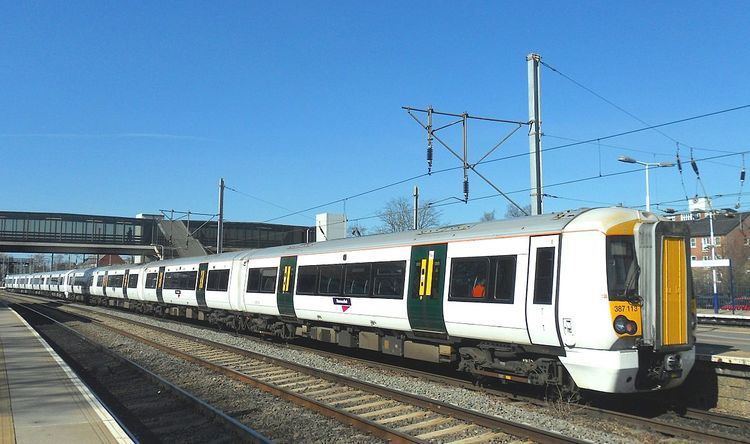Family name Electrostar | Formation 4 carriages | |
 | ||
In service 7 December 2014 (2014-12-07) - current Manufacturer Bombardier Transportation, Derby, UK Replaced Class 165 (GWR)
Class 166 (GWR)
Class 317 (GreatNorthern)
Class 319 (Thameslink)
Class 321 (GreatNorthern)
Class 442 (Gatwick Express) Number built 107 units to be built (428 carriages) | ||
The Class 387 Electrostar is an electric multiple unit (EMU) built by Bombardier Transportation for Thameslink, Great Northern, Gatwick Express, c2c and Great Western Railway (GWR), with the first delivered in December 2014.
Contents
These trains are part of the Electrostar family which also includes classes 357, 375, 376, 377, 378 and 379.
History
The Class 387 is an evolution of Bombardier’s Class 379 Electrostar with a higher maximum speed of 110 mph (175 km/h). This has allowed UK rail network operator Network Rail to release additional paths to train operators on routes with line speeds up to 125 mph (200 km/h).
Class 387/1
The first Class 387/1s were ordered for the Thameslink route, which enabled the existing Class 319s to be transferred to Northern Rail for use on the newly electrified Manchester Victoria to Liverpool via Newton-le-Willows route.
On behalf of the Department for Transport, Southern issued an OJEU notice in December 2012 with proposals received in January 2013. The invitation to tender for the fleet was released the following month with final offers being submitted by 18 June 2013. Southern announced it had signed a deal with Bombardier on 30 July 2013 for 29 four carriage units. The deal also included an option for 140 carriages which have since been taken up with 108 for Gatwick Express and 32 for Great Western Railway.
The first Thameslink unit entered service in December 2014 with all in service by July 2015. They are operated by Thameslink on services between Bedford and Brighton.
The first Great Western Railway unit entered service on 5 September 2016 running between London Paddington and Hayes & Harlington in peak hours to relieve congestion on some of the country's most crowded trains. From January 2017, GWR began running a half-hourly Paddington to Hayes and Harlington service utilising pairs of these 387/1s.
Class 387/2
As part of Govia's bid for the TSGN franchise, 27 four-carriage units were ordered to replace Class 442s on the Gatwick Express service, using some of the optional 140 extra carriages. The order was announced in November 2014 with the first units on test in July 2015 and they began to enter service on 29 February 2016. The deployment has been disrupted by drivers refusing to take passengers, claiming that the 12-coach class 387 trains are not covered by their driver only operation agreement which is limited to 10 coaches, and that running them without a conductor would be unsafe.
Class 387/3
In April 2016, c2c announced that it would operate six Class 387s until a fleet of 68 new carriages are delivered in 2019. The first c2c Class 387 was delivered in October 2016 and entered service in November 2016.
Future
It was originally planned that once the 387/1s were released from Thameslink they would be cascaded to the GWR franchise. It will also receive eight new Class 387s, which will be built after the end of March 2016 when the 387/2 order for Gatwick Express is scheduled to be completed. They will replace Class 165 and 166 diesel multiple units on the newly electrified Great Western Main Line from London Paddington to Oxford and Bedwyn.
In November 2015, Porterbrook announced it had ordered an additional 80 Class 387 carriages (20 four-car trains) to act as a buffer stock of trains guarding against future demand for electric units, with a number of operators already expressing interest in obtaining the use of them. In April 2016, c2c announced that it would operate six of the 20 additional units ordered by Porterbrook until a fleet of 68 new carriages are delivered in 2019. In June 2016 GWR announced that they would be taking the other 14 units of the Porterbrook order, plus another 23 new-build units, to add to the 8 already under construction, and would not be receiving the 29 Thameslink units, which will instead be going to Great Northern.
